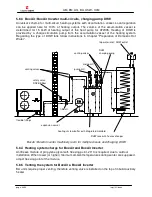
AM, EM, AQ, BA, ASW - IOM
page: 34/64
Ing.Ji
ř
í Jiránek
4.9 Piping Connection
!!! use 2 spanners !!!
The piping must be connected to the heat pump outlets using
connection screwed fittings. We recommend using fittings with
cone contact area and an O-ring. Never connect the screwed
fitting with cap nut and front contact area directly to the fitting of
the heat pump outlet, always use proper screwed fitting which is
usually a part of the screwed fitting set. For tightening always
use the wrench on the heat pump outlet to prevent turning over
or twisting off the outlet.
fitting top part
fitting bottom part
connection installation
4.10 Pressure and Leak Test
Before backfilling the collector system a Pressure and Leak Test must be performed. We
recommend testing all the individual loops by surplus pressure of 6 bars. The exception is with
certified probes in drill holes which were tested by the manufacturer. If in doubt, follow
instructions of the piping manufacturer. After the system completion the leak test of the whole
unit is performed by surplus pressure of 2,5 bars. The test is performed by filling the system
with water and pressuring it by air. The heat pump is disconnected during the test by closing the
valves. A written report about the test is made out.
4.11 Heat Insulation
After the Pressure and Leak Test is performed, heat insulation of earth collector piping inside
the building is performed. Always use insulation based on PUR, for example Armaflex, Kaiflex
etc. Recommended minimum wall thickness of insulation is 9mm.
The insulation must be “hermetical”. All joints of the insulation must thus be bonded using
special glue, or be taped over by self-adhesive insulation tape. The piping must be insulated
down to the heat pump cabinet. In the case the insulation is made in bad quality, the
condensate leaks into the heat pump cabinet and the cabinet corrodes. The underground piping
outside is insulated using PE insulation to a distance of app. 1m from the entry point (do not use
PUR insulation unless the piping is in the pipe sleeve).
insulation down to the cabinet
Heat insulation construction and closing
















































